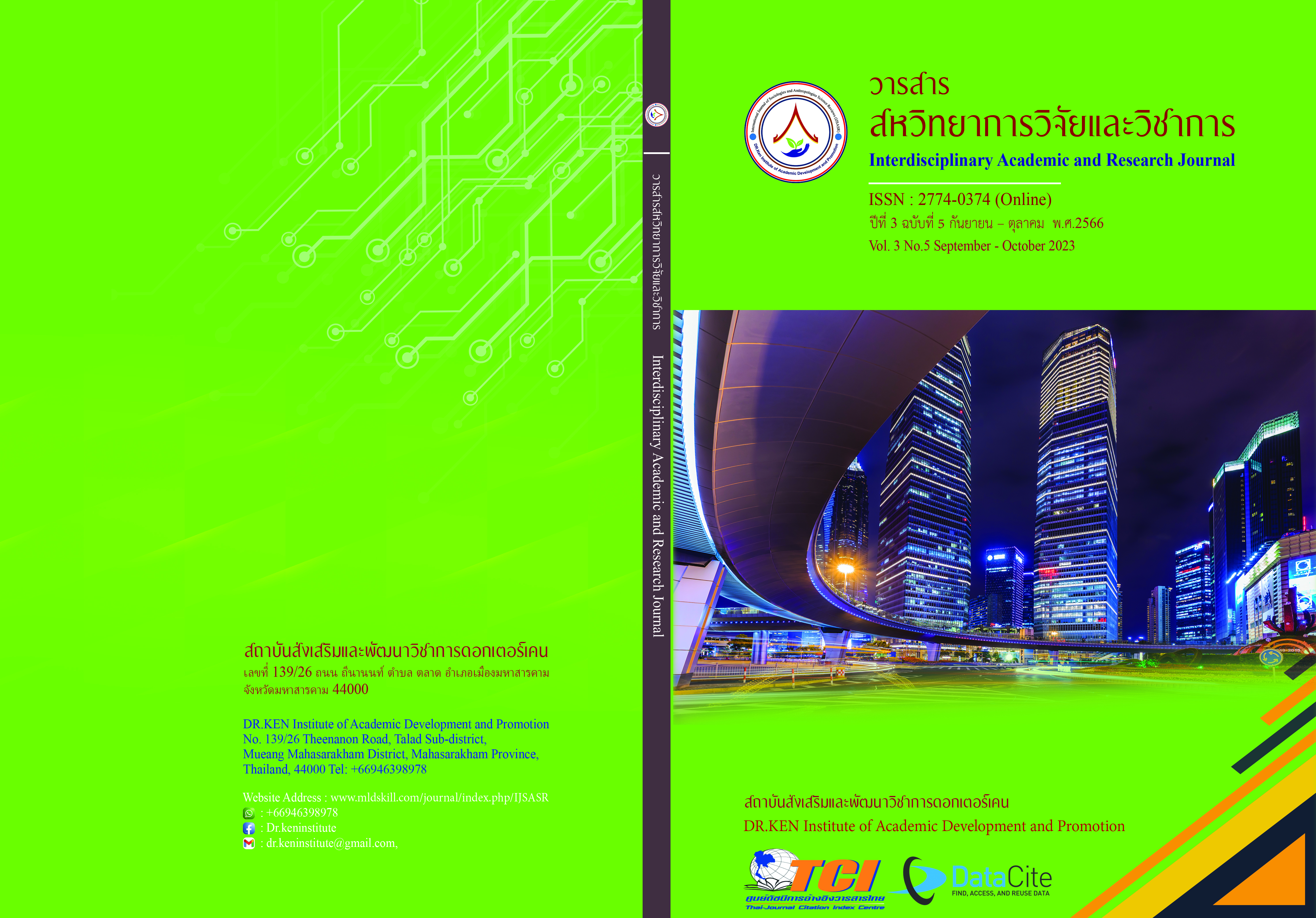A Study of Academic Achievement that Affects Algebraic Reasoning, Communication and Mathematical Presentation for Grade 7 Students
DOI:
https://doi.org/10.14456/iarj.2023.241Keywords:
Achievement; , Algebraic Reasoning; , Math Communication and PresentationAbstract
In teaching and learning at present, the problem is that students do not like to think and lack problem-solving skills, unable to apply knowledge to solve problems, the problem-solving experience in this class will be an important foundation leading to the development of thinking methods and enhancing problem-solving abilities. Thus, the objectives of this research were 1) to study the level of mathematical algebraic reasoning on single variable linear equations; of Grade 7 students. 2) to study the communication and presentation of mathematics on One Variable Linear Equation of Grade 7 students and 3) students to study the impact of academic achievement on algebraic reasoning. Math communication and presentation of Grade 7 students. The sample used in the research was Grade 7 students at Wapi Pathum School. A total of 218 students. Research instruments were 1) a mathematical reasoning test and 2) a communication and presentation test in mathematics. The statistics used in the research were frequency, percentage, mean, and standard deviation. The results showed that 1) the level of reasoning mathematics of the students. In descending order, they were level 3 (33.49%), followed by level 4 (22.94%), level 1 (22.02%), and level 2 (21.56%). student mathematics They were ranked in descending order as follows: good level (27.5%), moderate level (55%), and improved level (17.5%). 3) Students with weak mathematics achievement. There are levels of mathematical reasoning level 1 and level 2. There are levels of communication and presentation quality in mathematics. The level should be improved (37.16%) for students with moderate achievement in mathematics. There was a level of reasoning in mathematics at level 3. There was a level of communication and presentation in mathematics at a fair level (34.86%). Have a level of mathematical reasoning level 4, have a good level of communication and mathematical presentation quality (27.98%).
References
กรวิกา ปานศักดิ์, วนินทร สุภาพ และจักรกฤษ กลิ่นเอี่ยม. (2562). การพัฒนาความสามารในการสื่อสารทางคณิตศาสตร์และการนำเสนอด้วยการจัดการเรียนรู้แบบเสริมต่อการเรียนรู้ เรื่อง จำนวนจริง สำหรับนักเรียนชั้นมัธยมศึกษาปีที่ 4. วารสารศึกษาศาสตร์ มหาวิทยาลัยมหาสารคาม, 13(2), 32-44.
กระทรวงศึกษาธิการ. (2560). ตัวชี้วัดและสาระการเรียนรู้แกนกลางกลุ่มสาระการเรียนรู้ คณิตศาสตร์ (ฉบับปรับปรุง พ.ศ. 2560) ตามหลักสูตรแกนกลางการศึกษาขั้นพื้นฐาน พุทธศักราช 2551. กรุงเทพมหานคร : โรงพิมพ์ชุมนุมสหกรณ์การเกษตรแห่งประเทศไทย.
กิตติ พัฒเนตระกูลสุข. (2546). การเรียนการสอนคณิตศาสตร์ในระดับมัธยมศึกษาของประเทศไทย ล้มเหลวจริงหรือ. วารสารคณิตศาสตร์, 46(532), 54-58.
ฝ่ายวิชาการ โรงเรียนวาปีปทุม. (2565). รายการการสำรวจผลการเรียนวิชาคณิตศาสตร์ของนักเรียนในโรงเรียนวาปีปทุม. มหาสารคาม: โรงเรียนวาปีปทุม อำเภอวาปีปทุม
พรพิมล แก้วละมุล. (2562). การศึกษาความสัมพันธ์ระหว่างความสามารถในการให้เหตุผลเชิงสัดส่วนกับการแก้ปัญหาทางคณิตศาสตร์ของนักเรียนชั้นมัธยมศึกษาปีที่ 1. ปริญญาครุศาสตรมหาบัณฑิต: มหาวิทยาลัยราชภัฏมหาสารคาม.
พรรณทิพา พรหมรักษ์. (2552). การพัฒนากระบวนการเรียนการสอนโดยใช้กระบวนการวางนัขทั่วไปเพื่อส่งเสริมความสามารถในการให้หตุผลทางพีชคณิตและการสื่อสารทางคณิตศาสตร์ของนักเรียนมัธยมศึกษาปีที่ 3. กรุงเทพฯ: จุฬาลงกรณ์มหาวิทยาลัย
พิมพ์สุภา วุ่นเหลี่ยม.(2563). ความสามารถในการแก้ปัญหาและการสื่อสารทางคณิตศาสตร์ เรื่อง สมการเชิงเส้นตัวแปรเดียวของ นักเรียน ชั้นมัธยมศึกษาปีที่ 1 โดยใช้วิธีการแบบเปิด. มหาสารคาม: มหาวิทยาลัยมหาสารคาม.
สถาบันทดสอบทางการศึกษาแห่งชาติ (2565). รายงานผลการทดสอบทางการศึกษาระดับชาติขั้นพื้นฐาน O-NETม.3 ปี 2564. กรุงเทพฯ: สถาบันทดสอบทางการศึกษาแห่งชาติ.
สถาบันส่งเสริมการสอนวิทยาศาสตร์และเทคโนโลยี. (2551). ทักษะ/กระบวนการทางคณิตศาสตร์. กรุงเทพฯ: ห้างหุ้นส่วนจำกัด ส เจริญการพิมพ์.
อาริยา ไพโรจน์. (2564). การศึกษาความสามารถในการสื่อสารและการสื่อความหมายทางคณิตศาสตร์ โดยใช้การจัดการเรียนรู้แบบ TGT สำหรับนักเรียนชั้นมัธยมศึกษาปีที่ 1. กำแพงเพชร : มหาวิทยาลัยราชภัฏกำแพงเพชร
อิสริยะ อรัญมิตร. (2560). การศึกษาผลสัมฤทธิ์ทางการเรียนคณิตศาสตร์กับการให้เหตุผลทางคณิตศาสตร์ เรื่อง ตรรกศาสตร์ ของนักเรียนชั้นมัธยมศึกษาปีที่ 4. ปริญญาครุศาสตรมหาบัณฑิต : มหาวิทยาลัยราชภัฏมหาสารคาม.
Jones, G.A., Thornton, C.A., Langrall, C.W., & Tarr, J.E. (1999). Understanding Students Probabilistic Reasoning. In L.V. Stiff & F.R. Curcio (Eds.), Developing Mathematical Reasoning in Grades K-12 (pp. 146-156). Reston, VA: National Council of Teachers of Mathematics.
Basir, M.A., Waluya, S., Dwijanto, & Isnarto. How Students use cognitive structures to process information in algebraic reasoning? European Journal of Educational Research.11(2), 821-836. doi:10.12973/eu-jer.11.2.821
Yamane, T. (1973). Statistics: An Introductory Analysis. 3rd Edition, New York: Harper and Row.
Downloads
Published
How to Cite
Issue
Section
License
Copyright (c) 2023 Wasuthida Boonying, Navapon Nontapa

This work is licensed under a Creative Commons Attribution-NonCommercial-NoDerivatives 4.0 International License.
Copyright on any article in the Interdisciplinary Academic and Research Journal is retained by the author(s) under the under the Creative Commons Attribution-NonCommercial-NoDerivatives 4.0 International License. Permission to use text, content, images, etc. of publication. Any user to read, download, copy, distribute, print, search, or link to the full texts of articles, crawl them for indexing, pass them as data to software, or use them for any other lawful purpose. But do not use it for commercial use or with the intent to benefit any business.
















.png)


